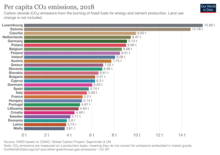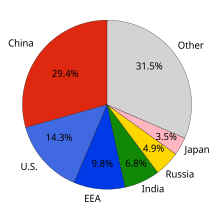
Back الصفقة الأوروبية الخضراء Arabic Avropa üçün yaşıl pakt AZ Европейски зелен пакт Bulgarian Pacte Verd Europeu Catalan Zelená dohoda pro Evropu Czech European Green Deal Danish European Green Deal German Ευρωπαϊκή Πράσινη Συμφωνία Greek Eŭropa Verda Pakto EO Pacto Verde Europeo Spanish



The European Green Deal, approved in 2020, is a set of policy initiatives by the European Commission with the overarching aim of making the European Union (EU) climate neutral in 2050.[1][2] The plan is to review each existing law on its climate merits, and also introduce new legislation on the circular economy (CE), building renovation, biodiversity, farming and innovation.[2]
The president of the European Commission, Ursula von der Leyen, stated that the European Green Deal would be Europe's "man on the moon moment".[2] On 13 December 2019, the European Council decided to press ahead with the plan, with an opt-out for Poland.[3] On 15 January 2020, the European Parliament voted to support the deal as well, with requests for higher ambition.[4] A year later, the European Climate Law was passed, which legislated that greenhouse gas emissions should be 55% lower in 2030 compared to 1990. The Fit for 55 package is a large set of proposed legislation detailing how the European Union plans to reach this target.[5]
The European Commission's climate change strategy, launched in 2020, is focused on a promise to make Europe a net-zero emitter of greenhouse gases by 2050 and to demonstrate that economies will develop without increasing resource usage. However, the Green Deal has measures to ensure that nations that are already reliant on fossil fuels are not left behind in the transition to renewable energy.[6][7][8] The green transition is a top priority for Europe. The EU Member States want to reduce greenhouse gas emissions by 55% by 2030 from 1990 levels, and become climate neutral by 2050.[9][10][11][12]
Von der Leyen appointed Frans Timmermans as Executive Vice President of the European Commission for the European Green Deal in 2019. He was succeeded by Maroš Šefčovič in 2023.[13]
- ^ Tamma, Paola; Schaart, Eline; Gurzu, Anca (11 December 2019). "Europe's Green Deal plan unveiled". POLITICO. Retrieved 29 December 2019.
- ^ a b c Simon, Frédéric (11 December 2019). "EU Commission unveils 'European Green Deal': The key points". euractiv.com. Retrieved 29 December 2019.
- ^ Rankin, Jennifer (13 December 2019). "European Green Deal to press ahead despite Polish targets opt-out". The Guardian. ISSN 0261-3077. Retrieved 29 December 2019.
- ^ Benakis, Theodoros (15 January 2020). "Parliament supports European Green Deal". European Interest. Retrieved 20 January 2020.
- ^ Higham, Catherine; Setzer, Joana; Narulla, Harj; Bradeen, Emily (March 2023). Climate change law in Europe: What do new EU climate laws mean for the courts? (PDF) (Report). Grantham Research Institute on Climate Change and the Environment. p. 3. Retrieved 2 April 2023.
- ^ "International investors enter Poland renewable energy market after rule change". European Investment Bank. Retrieved 20 May 2021.
- ^ Geden, Oliver; Schenuit, Felix; Stiftung Wissenschaft Und Politik (2020). "Unconventional Mitigation". SWP Research Paper. doi:10.18449/2020RP08. Retrieved 20 May 2021.
- ^ "€33 trillion investor group: strong EU climate targets key to economic recovery & future growth". IIGCC. Archived from the original on 9 January 2023. Retrieved 20 May 2021.
- ^ "Europe needs to forge ahead with renewable energy". European Investment Bank. Retrieved 23 December 2022.
- ^ "Fit for 55". consilium.europa.eu. Retrieved 23 December 2022.
- ^ Jaeger, Carlo; Mielke, Jahel; Schütze, Franziska; Teitge, Jonas; Wolf, Sarah (2021). "The European Green Deal – More Than Climate Neutrality". Intereconomics. 2021 (2): 99–107.
- ^ "Net Zero Coalition". United Nations. Retrieved 23 December 2022.
- ^ Mathiesen, Karl; Weise, Zia; Lynch, Suzanne (22 August 2023). "Šefčovič replaces Timmermans as EU Green Deal chief". Politico Europe. Retrieved 31 December 2023.